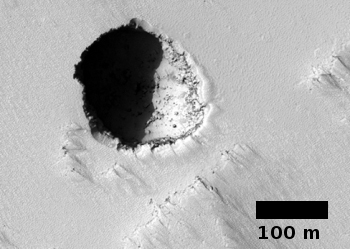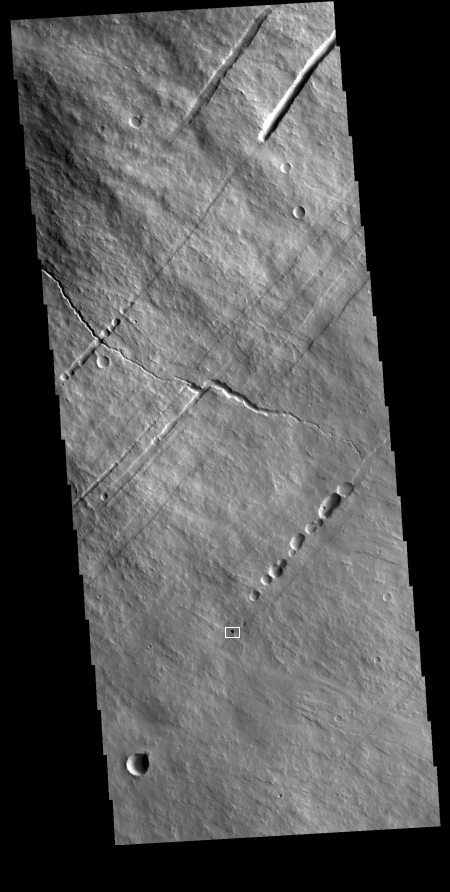Taking a look back at a Martian pit
The pit to the right could almost be considered the first “cool image” on Behind the Black. It was first posted on June 20, 2011. Though I had already posted a number of very interesting images, this appears to be the first that I specifically labeled as “cool.”
The image, taken by the high resolution camera on Mars Reconnaissance Orbiter (MRO), had been requested by a seventh grade Mars student team at Evergreen Middle School in Cottonwood, California, and shows a pit on the southeastern flank of the volcano Pavonis Mons, the middle volcano in Mars’ well-known chain of three giant volcanoes. A close look at the shadowed area with the exposure cranked up suggests that this pit does not open up into a more extensive lava tube.
What inspired me to repost this image today was the release of a new image from Mars Odyssey of this pit and the surrounding terrain, taken on July 31, 2019 and shown below to the right.
The white box indicates the area covered by the MRO image above. The top of the volcano is to the northwest, so that the slope heads downhill to the southeast.
The caption states that “the linear features [going from the northeast to the southwest] in the image are concentric faults.” Apparently, as Pavonis Mons rose it caused numerous concentric faults to form all around it, as shown by these features.
What is intriguing is the interplay between the lava flow depression going downhill at right angles to these concentric faults. That depression probably indicates the route taken by lava, either on the surface or in a lava tube below the depression itself. At one point that flow is redirected sideways for a short distance by one of those concentric faults, with most of the flow appearing to be pirated by that fault. When the remaining flow leaves that fault it continues downhill until it reaches another large lower fault, where it apparently gets entirely pirated to run within it to the southwest. The line of depressions within that lower fault suggests the existence of a lava tube, a supposition further reinforced by the pit.
What this wider image also suggests is that, even though the pit itself did not provide a direct skylight into a lava tube below, there are almost certainly underground voids of some kind here, running along that line of depressions. Mars’ lighter gravity and different composition would make these lava tubes different from Earth’s, but the superficial evidence does suggest they exist.
On Christmas Eve 1968 three Americans became the first humans to visit another world. What they did to celebrate was unexpected and profound, and will be remembered throughout all human history. Genesis: the Story of Apollo 8, Robert Zimmerman's classic history of humanity's first journey to another world, tells that story, and it is now available as both an ebook and an audiobook, both with a foreword by Valerie Anders and a new introduction by Robert Zimmerman.
The print edition can be purchased at Amazon or from any other book seller. If you want an autographed copy the price is $60 for the hardback and $45 for the paperback, plus $8 shipping for each. Go here for purchasing details. The ebook is available everywhere for $5.99 (before discount) at amazon, or direct from my ebook publisher, ebookit. If you buy it from ebookit you don't support the big tech companies and the author gets a bigger cut much sooner.
The audiobook is also available at all these vendors, and is also free with a 30-day trial membership to Audible.
"Not simply about one mission, [Genesis] is also the history of America's quest for the moon... Zimmerman has done a masterful job of tying disparate events together into a solid account of one of America's greatest human triumphs."--San Antonio Express-News
The pit to the right could almost be considered the first “cool image” on Behind the Black. It was first posted on June 20, 2011. Though I had already posted a number of very interesting images, this appears to be the first that I specifically labeled as “cool.”
The image, taken by the high resolution camera on Mars Reconnaissance Orbiter (MRO), had been requested by a seventh grade Mars student team at Evergreen Middle School in Cottonwood, California, and shows a pit on the southeastern flank of the volcano Pavonis Mons, the middle volcano in Mars’ well-known chain of three giant volcanoes. A close look at the shadowed area with the exposure cranked up suggests that this pit does not open up into a more extensive lava tube.
What inspired me to repost this image today was the release of a new image from Mars Odyssey of this pit and the surrounding terrain, taken on July 31, 2019 and shown below to the right.
The white box indicates the area covered by the MRO image above. The top of the volcano is to the northwest, so that the slope heads downhill to the southeast.
The caption states that “the linear features [going from the northeast to the southwest] in the image are concentric faults.” Apparently, as Pavonis Mons rose it caused numerous concentric faults to form all around it, as shown by these features.
What is intriguing is the interplay between the lava flow depression going downhill at right angles to these concentric faults. That depression probably indicates the route taken by lava, either on the surface or in a lava tube below the depression itself. At one point that flow is redirected sideways for a short distance by one of those concentric faults, with most of the flow appearing to be pirated by that fault. When the remaining flow leaves that fault it continues downhill until it reaches another large lower fault, where it apparently gets entirely pirated to run within it to the southwest. The line of depressions within that lower fault suggests the existence of a lava tube, a supposition further reinforced by the pit.
What this wider image also suggests is that, even though the pit itself did not provide a direct skylight into a lava tube below, there are almost certainly underground voids of some kind here, running along that line of depressions. Mars’ lighter gravity and different composition would make these lava tubes different from Earth’s, but the superficial evidence does suggest they exist.
On Christmas Eve 1968 three Americans became the first humans to visit another world. What they did to celebrate was unexpected and profound, and will be remembered throughout all human history. Genesis: the Story of Apollo 8, Robert Zimmerman's classic history of humanity's first journey to another world, tells that story, and it is now available as both an ebook and an audiobook, both with a foreword by Valerie Anders and a new introduction by Robert Zimmerman.
The print edition can be purchased at Amazon or from any other book seller. If you want an autographed copy the price is $60 for the hardback and $45 for the paperback, plus $8 shipping for each. Go here for purchasing details. The ebook is available everywhere for $5.99 (before discount) at amazon, or direct from my ebook publisher, ebookit. If you buy it from ebookit you don't support the big tech companies and the author gets a bigger cut much sooner.
The audiobook is also available at all these vendors, and is also free with a 30-day trial membership to Audible.
"Not simply about one mission, [Genesis] is also the history of America's quest for the moon... Zimmerman has done a masterful job of tying disparate events together into a solid account of one of America's greatest human triumphs."--San Antonio Express-News




I wonder where that seventh grade student is now, eight years later? Hopefully they are doing great things in space or are almost ready too. Very cool for kids that young to be able to request this image.
SHARAD is an instrument on the Mars Reconnaissance Orbiter. It is a ground radar instrument with a resolution of 15 meters (https://en.wikipedia.org/wiki/SHARAD). Has any tried to use its data to look for lava tubes around mars volcanoes?
Terrence: From what I understand, the bulk of SHARAD’s research so far has been to look for buried water/ice. I am unaware of anyone doing what you suggest. At the same time, the results from SHARAD have not been given a lot of press, so this unawareness could simply be my ignorance.